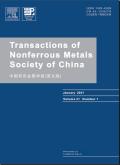拉瓦尔喷嘴顶吹射流流动特性的湍流数值模拟
IF 4.7
1区 材料科学
Q1 METALLURGY & METALLURGICAL ENGINEERING
Transactions of Nonferrous Metals Society of China
Pub Date : 2025-04-01
DOI:10.1016/S1003-6326(24)66753-1
引用次数: 0
摘要
通过数值模拟研究了顶吹拉瓦尔喷管的湍流特性以及压力和马赫数的影响。结果与实验式误差为2.72%,具有较好的可靠性。喷嘴流体受管道结构的影响,导致压力和密度随着速度的增加而下降。射流与周围气体之间的压力和速度差异导致射流速度衰减、流动膨胀、偏转和涡流。最优顶吹压力为0.6 MPa,在20De (De为喷嘴出口直径)下,射流中心速度为345 m/s,射流宽度为0.124 m。它的最大喷射速度达到456米/秒。最优喷管马赫数为1.75,最大射流速度为451 m/s。在20度时,射流中心速度为338 m/s,宽度为0.12 m。本文章由计算机程序翻译,如有差异,请以英文原文为准。
Turbulence numerical simulation of flow characteristics of Laval nozzle top blow jet
The turbulent characteristics of the top-blown Laval nozzle and the influence of pressure and Mach number were studied through numerical simulation. With 2.72% error between the results and the empirical formula, the results are reliable. Nozzle fluid is influenced by pipe structure, causing pressure and density to drop as speed increases. Differences in pressure and velocity between the jet and surrounding gas lead to jet velocity attenuation, flow expansion, deflection, and eddy currents. The optimal top blowing pressure is 0.6 MPa, and the center velocity and width of the jet are 345 m/s and 0.124 m, respectively, at 20De (De is the nozzle exit diameter). It achieves a maximum jet velocity of 456 m/s. The optimal nozzle Mach number is 1.75, with a maximum jet velocity of 451 m/s. At 20De, the jet center velocity is 338 m/s, with a width of 0.12 m.
求助全文
通过发布文献求助,成功后即可免费获取论文全文。
去求助
来源期刊
CiteScore
7.40
自引率
17.80%
发文量
8456
审稿时长
3.6 months
期刊介绍:
The Transactions of Nonferrous Metals Society of China (Trans. Nonferrous Met. Soc. China), founded in 1991 and sponsored by The Nonferrous Metals Society of China, is published monthly now and mainly contains reports of original research which reflect the new progresses in the field of nonferrous metals science and technology, including mineral processing, extraction metallurgy, metallic materials and heat treatments, metal working, physical metallurgy, powder metallurgy, with the emphasis on fundamental science. It is the unique preeminent publication in English for scientists, engineers, under/post-graduates on the field of nonferrous metals industry. This journal is covered by many famous abstract/index systems and databases such as SCI Expanded, Ei Compendex Plus, INSPEC, CA, METADEX, AJ and JICST.

 求助内容:
求助内容: 应助结果提醒方式:
应助结果提醒方式:


